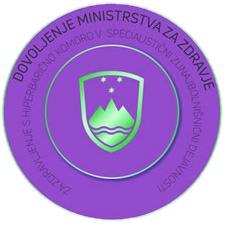Coronavirus and Hyperbaric Oxygen Therapy – Proven Effectiveness of HBOT in Treating COVID-19
Here is the English translation of the text you provided:
Review of the World Literature
Vladan Stanojković, MD, specialist in otorhinolaryngology and the first expert in hyperbaric and diving medicine in Slovenia (authorized by the Medical Chamber of Slovenia and the Ministry of Health)
OXYMED POLYCLINIC d.o.o.
Tomažičev trg 2, 6000 Koper
www.oxymed.si |
Introduction
The use of hyperbaric oxygen therapy (HBOT) in treating COVID-19 disease is supported by several international clinical studies, and its effectiveness is also recognized by the World Health Organization as one of the non-pharmacological therapies. Clinical trials are ongoing in Europe, the Middle East, and North America to confirm its approval at national levels according to specific legislation in each country.
While scientific discussion focuses on comprehensive clinical documentation, that is not the direct purpose of this document. Dr. Serena, who collects data from various parts of the country, reports a high recovery rate in patients receiving HBOT—according to her, 80 to 90 percent of cases. Dr. Harch points out that many physicians deciding on patient intubation are not even aware of HBOT as an alternative therapy option.
Although scientific research is often lengthy and costly, HBOT supporters remain optimistic about its establishment as a standard treatment method.
Proven Effectiveness of HBOT in Treating COVID-19
Statement:
Prim. Dr. Miodrag Živković, specialist in maritime, hyperbaric, and underwater medicine and physiology
- Lungs and Mechanism of Injury in COVID-19:
The SARS-CoV-2 virus primarily attacks type 2 pneumocytes, which produce surfactant—a key factor for maintaining open alveoli and effective gas exchange. Damage to these cells leads to reduced surfactant production, thickening of the alveolar-capillary membrane, and atelectasis, causing various degrees of hypoxia and resulting in ARDS.
At the beginning of the pandemic, American doctors used HBOT on 40 patients with severe pneumonia (2.0 ATA, 60 minutes). In Sweden, a multicenter study is ongoing with 200 patients (2.4 ATA, 30–60 minutes). In Russia, HBOT is routinely used for severe pneumonia, though published results are not yet available.
Dr. Živković recommends HBOT at low or moderate pressures (1.2–1.5 ATA) but with longer duration (up to 120 minutes), 2–3 times daily, depending on disease severity. HBOT is preferred over mechanical ventilation since it does not cause mechanical lung injury. He also recommends adding exogenous surfactant.
- Systemic Effects of SARS-CoV-2:
The virus destroys erythrocytes and releases large amounts of iron, causing additional hypoxia, especially dangerous for patients with chronic diseases. Therapy with erythropoietin (e.g., Recormon) increases erythrocyte count, raises hemoglobin, and consumes excess iron—thus reducing toxic oxidative stress. - Adjuvant Therapies:
In addition to HBOT and erythropoietin, antibiotics, high doses of antioxidants, and symptom management are advised. - Role of HBOT:
HBOT has anti-hypoxic, anti-inflammatory (inhibiting IL-1β, TNF-α), regenerative (stimulates stem cells), indirect antimicrobial, and antithrombotic effects. It improves blood rheology, increases erythrocyte elasticity, and influences cellular energy status.
Analysis by Prof. Sharif Sultan, April 16, 2020
(President of the International Society for Vascular Surgery)
Based on autopsy analyses and clinical observations in the USA, Europe, and the UK, COVID-19 causes pulmonary thrombosis, which is not typical of ARDS. Hypoxemia does not respond to PEEP but does respond to high oxygen concentrations. Viral structural proteins bind heme and displace oxygen, leading to toxicity, iron release, and cytokine storm.
Key findings:
- The virus causes hemolysis and metabolic hypoxia, similar to carbon monoxide poisoning.
- COVID-19 is not classical pneumonia—erythrocytes and their oxygen-binding capacity are affected.
- Free iron causes oxidative stress and lung inflammation.
- Clinical severity markers include oxygen saturation, ALT, and thrombocytosis.
Therapeutic proposals:
- HBOT with 100% oxygen (1.2–1.5 ATA, 90–120 minutes, 2–3 times daily, at least 5 days).
- Plasmapheresis and fresh erythrocyte transfusions.
- Treatment with low PEEP and high oxygen flow.
- Use of antioxidants and iron chelators.
- Early HBOT application in patients with risk factors (diabetes, obesity, heart disease).
Clinical results:
In all clinical trials where HBOT was used, critically ill patients fully recovered if therapy was started timely. Even patients with multiple risk factors were completely cured using HBOT.
If you want, I can help format this into a professional report or presentation. Would you like me to do that?







